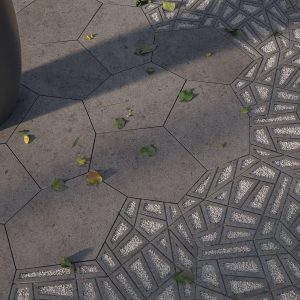Landscapism in Nature Conservation

Having studied landscape approaches to nature conservation in Tanzania for my doctoral dissertation (Bluwstein 2018), I developed a critical – dare I say, even sceptical – view on the term landscape. To be sure, the term can be analytically productive to study nature-society relations. The variety of engagements with the notion of landscape in cultural geography, anthropology, political ecology and environmental history highlights its politically contentious and conflicted, ideological, imaginative, discursive, material and embodied dimensions (Kühne et al., 2019; Beardsley, 2016; Neumann, 2011; Mitchell, 2001; Görg, 2007; Wylie, 2007). And yet, the term can also be politically dangerous when wielded by more powerful actors (including scientists!) against groups that are already marginalized in society. Critiques associate landscape thinking with vehicles of vested interests and regimes of power written on the land. In other words, as a set of practices of symbolic and material appropriation and exclusion (Wylie, 2007, p. 14). For instance, Marxist geographer Don Mitchell sees landscape as “a relationship of alienation” (Mitchell, 2001, p. 272) and cultural historian Raymond Williams insists that “[t]he very idea of landscape implies separation and observation” (Williams, 1975, p.120). To Mitchell, there is a historical lineage between the violent genealogy of property as shown by Nick Blomley (1998) and the material and symbolic construction of landscapes. These insights from North America and England resonate with the political ecology of conservation in East Africa as highlighted by geographer Rod Neumann (1998). Neumann (1998, p. 3) traces how the colonial idea of a “scenic African landscape” travelled from Europe to Tanganyika to reclaim ancestral territories of rural land and resource use as wilderness areas for Western nature consumption and (post)colonial state control. To Neumann, this was a “contestation over landscape meaning and representation” (1998, p. 176). Drawing on work in Southeast and South Asia, geographers Daniel Friess and Tariq Jazeel (2017, p. 15) propose that landscapes defined as spatially bounded containers “exclude or obscure other kinds of geographies, other claims, and other spatial experiences and intuitions”. This leads the authors to see landscape as “a narrative, one that is spatially and taxonomically partial, exclusive, and duplicitous”. Environmental historians Thomas Lekan and Thomas Zeller (2014, p. 26) conclude in their extensive review that historians and geographers understand the landscape phenomenon as “the nexus between the material and the visual, between appropriation and appreciation”.
These insights suggest that landscape is above all a powerful idea with material consequences. Rather than taking landscapes for granted as given spaces where nature and culture meet, I propose that we should begin our inquiry by paying attention to landscapism[2], how the idea of landscape is mobilized to see, know, and intervene in nature-society relations. In my 2021 article, I lay out in more detail how landscapism is underpinned by the double movement of colonizing landscapes/landscaping colonies, a historical process of internal colonization of (northern) European communities which were known as landscapes/-scab/-schaften (see Olwig 2002), followed by European colonial expansion across the rest of the world (see Grove 1996). Seen this way, the history of internal colonization of autonomous political communities across Europe can be narrated as a history of colonizing landscapes, and the history of European colonial expansion beyond Europe as a global history of landscaping colonies. From this vantage point, my own research on the landscape approach to nature conservation around the Tarangire National Park in Tanzania has led me to question the widespread landscapism which conservation NGOs, their donors, and governmental and international authorities have adopted to implement conservation projects all over Tanzania, East Africa, and even the African continent as a whole.
- European Comission 2015: ‘“Larger than elephants”. Combating wildlife trafficking, conserving biodiversity, reducing poverty: the EU approach.’
For instance, the Tarangire Conservation Area Management Plan states the following:
“The spectacular landscape values of the Tarangire Conservation Area provides an important part of the visitors overall Tarangire experience. The grassland plains, the Gosuwa and Silale swamps from the highlands, the baobab/acacia mosaic, rift valley and Kilimanjaro/Meru views are all key elements of the landscape The appeal of many of these experiences is the absence of human development. Unmodified landscapes give a sense of remoteness and are an important experience and retreat for many visitors.” (King 2009[3])
This raises several questions: what landscape values are meant here? What makes them spectacular and for whom? Understanding landscape as a way of seeing (Cosgrove, 1985), we can ask who is seeing here? The management plan, at least, is clear that the “Tarangire experience” is for “visitors” to enjoy. Visitors are here first and foremost global tourists whose “experience” must be sanitized through “the absence of human development”, that is, of Tanzanians living and working in the area. Put differently, local people, their labor and productive activities are excluded from the landscape vision of Tarangire as one of Tanzania’s “iconic landscapes” (if you google “iconic landscape”, you will see).
The author of the above-cited management plan is Simon. J. King. According to an obituary by his brother-in-law, King was born 1961 in Australia, and worked as a mining engineer before moving to Tanzania in 1991 to start a safari company. In the mid-1990s he pioneered one of the first joint ventures with local Maasai communities: the Maasai would forego farming and livestock grazing in certain areas to allow wildlife to roam free in return for benefits from photographic tourism. In 2016, King received a silver award in the World Responsible Tourism Awards at the World Travel Market in London.
And indeed, there is much to see around Tarangire, especially its large elephant population for which Tarangire is famous. So much so, that the African Wildlife Foundation, an international conservation NGO, has declared Tarangire to the “Maasai Steppe Heartland” in the 1990s. In one of its publications, AWF describes its “African Heartland Program” as follows:
“African Heartland Program strives to conserve Africa’s wildlife in large cohesive conservation landscapes [..] to maintain healthy populations of wild species and natural ecological processes in perpetuity. The desirability of conserving large areas is an almost universally accepted principle in conservation biology. The African Heartlands aim to maintain the ecological integrity of the landscape over time [..] AWF supports in situ conservation by linking existing protected areas with natural areas to form a contiguous landscape. These landscapes are biologically coherent and safeguard livelihoods for local people (e.g., development of conservation enterprises)”(AWF 2005, 2).
- Source: Sachedina 2008
Former AWF employee Hassan Sachedina highlighted in his PhD dissertation that “Heartlands” appeal to AWF’s US donors (Sachedina 2008). From the vantage point of landscapism, I suggest that Tarangire was “landscaped” to become a global tourist destination, a vehicle to generate funding for conservation NGOs, and an important research site for conservation scientists. Conservation sciences have embraced a new objectivist landscape turn since the 1990s, which posits that socio-ecological systems and associated environmental problems can be best understood and intervened in through the so-called landscape approach. This approach has paved the way for the revival of a landscape concept as an a priori given space and container with particular ecological, biophysical and cultural properties – nature-society relations – that can be objectively determined through a positivist methodology of field-based observations, geospatial analytics, modelling and quantification (Kühne et al., 2019). The promise of the landscape approach lies in conceptualizing nature-society relations in a more comprehensive, holistic fashion by including and balancing the needs of different stakeholders in order to achieve social, economic, environmental, cultural, and to some degree political objectives (Reed et al., 2017). The landscape approach thus suggests that a “true”, total representation of nature-society relations in space is possible and desirable, if only all stakeholders contribute to describing the landscape’s inventory – its natural and cultural elements and objects (Minca, 2007).
Depoliticization, simplification, representation
I argue that the landscape approach to nature-society relations suffers from three related problems. First, it depoliticizes the stakes in nature-society relations by rendering analysis of and interventions in environmental problems as technical issues. Second, it simplifies and decomplexifies nature-society relations through positivist epistemologies. Third, it promotes exclusion through representation, a colonial logic of a landscape way of seeing which is applied to improve these relations.
The first problem arises from the fact that scholars and practitioners who work with the landscape approach privilege a positivist outlook in studying nature-society relations. This perspective tends to advance science-based claims to landscapes as spatial containers and totalities, instead of examining the question “Who owns, shapes and claims landscape?” (Friess & Jazeel 2017, p. 15). There is little space for marginalized voices, contested and irreconcilable visions about what constitutes desirable nature-society relations in such a science-led framework of “enlightened specialists” and “expert observers” (Groening, 2007, p. 606; Wylie, 2007, p. 5).
The problem of depoliticization dovetails with the second problem, the question of what kind of knowledge practices promote the landscape approach. The object of analysis and intervention of the landscape approach are the nature-society relations, not steady states of ecology and society, natural habitat and autonomous culture (Sheridan, 2009; Wylie, 2007). What kind of science underpins a landscape approach to conservation is thus both an epistemological and political question. Anthropologists of conservation, West et al. (2006, p. 265) highlight how through a positivist epistemology, conservation science decomplexifies nature-society relations, enabling scientists “to legislate the social relations between people and their surroundings”. This leads the authors to conclude that “conservation, similar to colonialism, solidifies certain identities and ethnicities and incarcerates them in space and place” (p. 264). This critique from anthropology resonates with critical studies of conservation initiatives through the landscape approach (Clay, 2019; Clay, 2016; Bluwstein, 2018; McCall, 2016). This critique also resonates with post-colonial scholarship in geography, which insists that scientific enframing and representation of non-European socionatures as landscapes is “inherently colonizing” (Gregory, 2001, p. 93; Willems-Braun, 1997). Representation is an attempt to “superimpose a framework of meaning” (Mitchell, 1991) in order to make nature “available for inspection, codification, calculation, and regulation” (Gregory, 2001, p. 93). Landscape-based conservation science and practice is a prime example of such an attempt to determine what should be counted and accounted for as part of a landscape or not.
Following Derek Gregory’s reconstruction of Edward Said’s work on “imaginative geographies”, a post-colonial critique of representation thus highlights how places and identities are “drawn into abstract grids of colonial and imperial power” and how they become “sites of appropriation, domination and contestation” (Gregory, 1995, p. 448). In short, the power of representation lies in claiming “empirical authority” and “colonial legitimacy” (p. 461). However, critique of representation may seem totalizing if there is no way out of representation. Is it not the role of science to represent? Here, Doreen Massey offers a way out by inviting us to embrace relationality as opposed to representation, when thinking about space (Massey, 2005). Importantly, relationality (between humans and humans, and humans and nonhumans) produces relations of responsibility and “a degree of interdependence that in many ways defies measurement” (Smith et al., 2007, p. 350; Setten, 2017).
Critical perspectives thus hold that nature-society relations cannot be represented – abstracted, enumerated, spatially mapped and modelled – with the tools of positivist landscape science without sacrificing complexity and dismissing more-than-human relationality and responsibility. Seen this way, I propose that we cannot decolonize nature conservation without decolonizing our way of seeing land and nature-society relations inscribed in it as landscapes. Decolonization is not about integrating local, marginalized, subaltern knowledges into scientific practices (Goldman, 2020). On the contrary, decolonization begins with epistemic disobedience (Mignolo, 2011). Importantly, demands for decolonization do not stop with the domain of science and knowledge production. Above all, land has to be given back and colonial property relations dismantled where they persist in settler- or post-colonial contexts (Tuck and Yang, 2012). From this vantage point, I understand calls to decolonize conservation as a questioning and overcoming of “the biopolitical and geopolitical management of people, land, flora and fauna” (Tuck & Yang 2012, p. 4). Ultimately, Tuck and Yang (2012) insist that we need to attend to the irreconcilable in colonial structures and legacies, if we take decolonization seriously.
So what is irreconcilable in the landscape approach to conservation? I argue that the landscape way of seeing imbues conservation and environmental scientists and practitioners with the power to represent people and their relationships to land and the environment. Representation is central to how cultural geographers understand the power of a landscape way of seeing in science and modernity. Representation is a particular epistemological model, an elevated, seemingly objective and detached vantage point from which one looks at the assemblage of land, people, and the environment (in short, nature-society relations) as a landscape (Wylie, 2007). Given that positivist methodologies are the preferred choices in landscape-based analysis and intervention, there is a tendency in the landscape approach to conservation to simplify and erase socio-ecological complexity and more-than-human relationality that make up the socionatural fabric. This sort of scientific rationalization is at once an exercise of power to represent and an illustration of the limits of representation (Dalton et al., 2019; Massey, 2005). I argue that conservation and environmental science cannot reconcile and settle this tension, because the way in which landscapism represents nature-society relations is a fundamentally exclusive perspective, which is “implicated in the general operations of colonizing power” (Gregory, 2001, p. 93).
To be sure, a post- and decolonial critique of the landscape approach to conservation will resonate more strongly outside of Europe than within. In post-war Europe, contemporary conservation initiatives face the problem of collective action, the question of how different stakeholders can be mobilized to jointly work together towards environmental goals in a given landscape (Adams et al., 2014)[4]. In many regions outside of Europe, particularly in imperial and post- or settler-colonial settings (Davis and Burke, 2011), the challenge of collective action for conservation is overshadowed by the politics of landscape belonging, the question of whose landscape vision counts and who is included and excluded within this vision (Toomey, 2020; Friess & Jazeel, 2017; Willems-Braun, 1997).
Landscaping Africa
Unlike in regions where concerns with the disappearance of landscapes as cultural heritage prevail (most prominently in Europe), contemporary African landscape conservation initiatives tend to associate landscapes with natural, timeless spaces threatened by growing human activities. Although it is debatable if the concept of landscape is an appropriate term to make sense of African spaces (see edited volume in Beardsley, 2016), there is a consensus that a colonial way of seeing and representing an exclusive, natural landscape was imposed on the African continent despite an extensive human presence and a deep cultural history (Beardsley, 2016; Sheridan, 2009; Eeden, 2004; Adams & Mulligan, 2003; Guyer & Richards, 1996). This way of seeing and representing African peoples and spaces was underpinned by Malthusian, essentialist, and romantic images of an Edenic landscape untouched by human civilization (Ramutsindela, 2016; Davis and Burke, 2011; Neumann, 1998; Guyer & Richards, 1996; Adams & McShane, 1992; Anderson & Grove, 1988).
See, for instance, how UNESCO classified the Cévennes region in France as a World Heritage Site in 2011, seeing an ancient “agro-pastoral cultural landscape” worthy of protection. Now compare with how UNESCO placed Simien Park in Ethiopia on the list of World Heritage in Danger in 1996 (having recognised it as a Heritage Site in 1978) because it perceived the park’s human residents as a threat to the landscape (Blanc, 2016). Whereas in France, UNESCO is at pains in emphasising the “wholeness or intactness of the cultural landscape”, whose “traditional activities” must be maintained, supported and revived, in Ethiopia the same institution sees a “spectacular landscape” in need of protection from anthropogenic forces. To be sure, as in France, human residents of the Ethiopian World Heritage Site are acknowledged to have lived in the area prior to its recognition by UNESCO. However, unlike in France, humans are not celebrated as part of the landscape, but as a threat to it. To UNESCO, the Ethiopian park’s “integrity” is threatened by “human settlement, cultivation and soil erosion”, “frequent fires” and “excessive numbers of domestic stock”. While the stakes are significantly higher for rural people in Ethiopia (who are facing the risk of dispossession or eviction) than in France (who are expected to remain “traditional”), the similarities across both cases lie in the way in which UNESCO assumes a landscape way of seeing to project an idea of what a landscape should look like. In this sense, landscapism is a deeply conservative project (Groening, 2007). What is more, UNESCO’s heritage program in Africa illustrates landscapism’s enduring colonial legacy (Noe, 2019).
Since the 1990s, colonial visions of a landscaped Africa as a borderless space culminated in the proliferation of transboundary/ transfrontier conservation initiatives across nationstate borders, spearheaded in Southern Africa by the NGO Peace Park Foundation (Ramutsindela, 2017; Noe, 2010; Wolmer, 2003). The underlying motivation to transcend state borders in order to “re-naturalize” African landscapes to a pre-colonial state reveals the dominant vision of a continent whose people and their histories tend to be erased in western imagination (Ramutsindela, 2016). Yet, given the deeply interventionist and often coercive nature in which landscape-based conservation initiatives are introduced on the continent, landscaping Africa has led to more, not less, bordering when older state-led protected areas were reconfigured into large-scale NGO- and donor-driven landscape initiatives (Ramutsindela, 2007). These initiatives can include up to several million residents and are primarily motivated by biodiversity and natural resource conservation (Milder et al., 2014). Looking at the territorial extent of landscape initiatives on the continent, one could be inclined to equate their geography with a neocolonial scramble for Africa[5]. These initiatives require that someone is doing the work of representing African rural spaces as conservation landscapes – their scientific enframing and scripting as spatial containers with valuable nature and biodiversity, threatened by human “disturbance”. It is here that the role of conservation scientists and NGOs – often in confluence with the state – acting as landscape architects is paramount.
Conclusion: decolonizing landscapes?
My point is not to question nature conservation per se, but to highlight its colonial legacies in the present. What could decolonizing landscapes look like? Should we re-appropriate the landscape concept or should we do away with the concept altogether? Friess and Jazeel (2017) call for a third option – the provincialization of the landscape concept and its “unlearning” as a spatial descriptor. Don Mitchell’s challenge to go beyond “the fetishized landscape as our starting point” remains relevant (Mitchell, 2003, p. 790). Following Tim Mitchell, a decolonial perspective on landscapes and conservation has also to disavow “the metaphysic of representation” (Mitchell, 1991, p. xvi). Instead of representation, conservation has to start with acknowledging relationality (Goldman, 2020; Toomey, 2020). Here, phenomenological approaches to landscape as more-than-human embodiment, inhabitation, dwelling, and belonging may help counter a landscape way of seeing nature-society relations as spatialized containers (Wylie, 2007). At the very least, decolonizing landscapes is akin to refraining from understanding landscapes as visual sceneries, spatial containers, abstract ecologies, or static, autonomous cultural spaces. Instead, we need to conceptualize landscapes as places and polities imbued with politics, power and (in)justice (Olwig & Mitchell, 2007). In this vein, I call for a critical re-appropriation of the notion of landscape in conservation and environmental science, policy and practice, away from its technical and instrumental, scientific-positivist use. And ultimately, if decolonization should not remain a metaphor (Tuck and Yang 2012), decolonizing landscapes in settler- and post-colonial conservation contexts must be based on giving land back to people, whose historic dispossession has been entangled with the making of conservation landscapes.
Dr. Jevgeniy Bluwstein[1]
University of Bern, Switzerland
To explore this topic further:
Bluwstein, J. (2021). Colonizing landscapes/landscaping colonies: from a global history of landscapism to the contemporary landscape approach in nature conservation. Journal of Political Ecology 28(1), 904-927, https://doi.org/10.2458/jpe.2850
Bluwstein, J., Cavanagh, J., and Fletcher, R. (2023). Securing Conservation Lebensraum? The geo-, bio-, and ontopolitics of global conservation futures. Geoforum 153, 103752, https://doi.org/10.1016/j.geoforum.2023.103752
Bluwstein, J. (2018). From Colonial Fortresses to Neoliberal Landscapes in Northern Tanzania: a Biopolitical Ecology of Wildlife Conservation. Journal of Political Ecology 25, 144-168. https://doi.org/10.2458/v25i1.22865
Mason, O., & Riding, J. (2023). Reimagining landscape: Materiality, decoloniality, and creativity. Progress in Human Geography, 47(6), 769-789. https://doi.org/10.1177/03091325231205093
Barraclough, L. (2024). Indigenous Cultural Landscapes: Decolonizing Landscape Within Settler Colonial Societies. Annals of the American Association of Geographers, 1–21. https://doi.org/10.1080/24694452.2024.2400099
Footnotes
[1] Dr. Jevgeniy Bluwstein, Senior Research Fellow, Department of Social Anthropology and Cultural Studies, University of Bern, Switzerland. Email: jevgeniy.bluwstein@unibe.ch. This is a shortened version of a peer-reviewed article that was published in the Journal of Political Ecology (Bluwstein, 2021)
[2] What I propose to call landscapism echoes Bernard Debarbieux’ empaysagement, a neologism for our contemporary “invocation of landscape and of landscape concerns in any form of intervention” (Debarbieux, 2011, p. 141).
[3] Tarangire Conservation Area. Eneo la Hifadhi la Tarangire. Management Plan. Revised 2009. Simon J. King 2009
[4] But see Iordachescu (2021) for a case from Romania that points to important exceptions
[5] Already back in 1988, David Anderson and Richard Grove referred to “the scramble for Eden” through African conservation (Anderson & Grove, 1988), while Rod Neumann suggested that the rise of big international conservation NGOs in the second half of the 20th century constitutes “the second scramble for Africa” (Neumann, 2002, p.37). South African geographer Maano Ramutsindela sees an “imperialist vision for a continent-wide connectivity” at work through transfrontier conservation initiatives in Africa today (Ramutsindela, 2007, p. 136). Tanzanian geographer Christine Noe sees present conservation initiatives advanced by international conservation NGOs as economic vehicles to grant different actors access to land and mineral resources in a neocolonial scramble for the continent (Noe, 2019, p.2).
References
Adams, William M., and Martin Mulligan, eds. Decolonizing Nature: Strategies for Conservation in a Post-Colonial Era. Earthscan, 2003.
African Wildlife Foundation. African Heartlands: Landscapes for Wildlife Conservation and Human Development. AWF, 2005.
Anderson, David, and Richard Grove. Conservation in Africa: People, Policies, and Practice. Cambridge University Press, 1988.
Beardsley, John, ed. Cultural Landscapes of Sub-Saharan Africa. Dumbarton Oaks Research Library and Collection, 2016.
Blomley, Nicholas. “Property and the Geography of Violence: A Study of the Land Question in British Columbia.” Law and Society Review 32, no. 3 (1998): 561–91.
Bluwstein, Jevgeniy. “Colonizing Landscapes/Landscaping Colonies: From a Global History of Landscapism to the Contemporary Landscape Approach in Nature Conservation.” Journal of Political Ecology 28, no. 1 (2021): 904–27. https://doi.org/10.2458/jpe.2850.
Bluwstein, Jevgeniy, James Cavanagh, and Robert Fletcher. “Securing Conservation Lebensraum? The Geo-, Bio-, and Ontopolitics of Global Conservation Futures.” Geoforum 153 (2023): 103752. https://doi.org/10.1016/j.geoforum.2023.103752.
Bluwstein, Jevgeniy. “From Colonial Fortresses to Neoliberal Landscapes in Northern Tanzania: A Biopolitical Ecology of Wildlife Conservation.” Journal of Political Ecology 25 (2018): 144–68. https://doi.org/10.2458/v25i1.22865.
Davis, Diana K., and Edmund Burke III, eds. Environmental Imaginaries of the Middle East and North Africa. Ohio University Press, 2011.
European Commission. “Larger than Elephants: Combating Wildlife Trafficking, Conserving Biodiversity, Reducing Poverty: The EU Approach.” Brussels, 2015. https://www.cbd.int/doc/meetings/biodiv/rd-2015-01/other/rd-2015-01-presentation-03-en.pdf.
Friess, Daniel A., and Tariq Jazeel. “Unlearning the Landscape Concept.” Progress in Human Geography 41, no. 3 (2017): 275–94. https://doi.org/10.1177/0309132516645635.
Gregory, Derek. “Imaginative Geographies.” Transactions of the Institute of British Geographers 19, no. 4 (1995): 448–61.
Grove, Richard H. Green Imperialism: Colonial Expansion, Tropical Island Edens and the Origins of Environmentalism, 1600–1860. Cambridge University Press, 1996.
Kühne, Olaf, et al. Landscape Theories: A Brief Introduction. Springer, 2019.
Massey, Doreen. For Space. SAGE Publications, 2005.
Mitchell, Don. “The Lie of the Land: Migrant Workers and the California Landscape.” Cultural Geographies 8, no. 2 (2001): 271–89.
Mitchell, Timothy. Colonising Egypt. Cambridge University Press, 1991.
Neumann, Roderick P. Imposing Wilderness: Struggles over Livelihood and Nature Preservation in Africa. University of California Press, 1998.
Olwig, Kenneth R. Landscape, Nature, and the Body Politic: From Britain’s Renaissance to America’s New World. University of Wisconsin Press, 2002.
Sachedina, Hassan. “Wildlife Is Our Oil: Conservation, Livelihoods and NGOs in the Tarangire Ecosystem, Tanzania.” PhD diss., University of Oxford, 2008.
Sheridan, Michael J. “The Environmental and Social Costs of African Conservation.” Global Environmental Politics 9, no. 3 (2009): 1–25.
Tuck, Eve, and K. Wayne Yang. “Decolonization Is Not a Metaphor.” Decolonization: Indigeneity, Education & Society 1, no. 1 (2012): 1–40.
Wylie, John. Landscape. Routledge, 2007.
Published on November 20, 2024
































The strength of the article comes with the comparison of situations in Aftica with those in Europe. References to to the American experience with wilderness areas, public lands, national forests, parks and monuments would help clarify whether this is a usable broad view or an academic one.
I version of the paper written for a general audience (or customized for specific audiences) would be a good thing to do.
I particularly value the exploration of the colonizing landscape view. While framed within conservation concerns, I believe its principles can extend broadly to landscape architecture—encompassing design, aesthetics, planning, perception, and positionality. Bluwstein’s full-length article is available here and is a vital piece of research: https://journals.librarypublishing.arizona.edu/jpe/article/id/2850/.
If you’re aware of similar research conducted in the U.S. or elsewhere, I’d appreciate any references.
Thanks for sharing this valuable article – I’ve been asking similar questions from the perspective of landscape architecture education and practice research (in settler colonial contexts). I find accord with your ideas that refuse to cart ‘landscape’ and its past legacy into the situations of the present. An’unlearning’ and perhaps a reckoning is underway, yet Im unconvinced by claims that redefine landscape without reconciling with the aesthetic preferences that continue to reappear in collective imaginations. I’ve observed in my work with students how hard collective landscape imaginations are to shake off. As an aside I trialled (non)landscape to mark a similar shift alongside responsibility-based relational ontologies to critically cut across embedded EuroAmerican-centric taxonomies and associated aesthetic preferences. See 2020 article: https://kerb-journal.com/articles/non-landscape-and-general-ecology-as-agents-of-creativity
I’m v interested in “What could decolonizing landscapes look like?” and have be generating some findings. Get in touch if you’d like to discuss.
Thanks Hannah, I was thinking how to dismantle aesthetic principles that stem from hierarchical world-views – symmetry, tapis vert expressed in lawn, neatly cut borders, one-species-tree alleys and other design formalisms that replicate until today, and could be overcome by tools that landscape architecture already uses (biodiversity, naturalisation of water streams, successive planting, etc.) but doesn’t yet addresses as decolonizing practices (or?). I’m interested too, how to develop this.